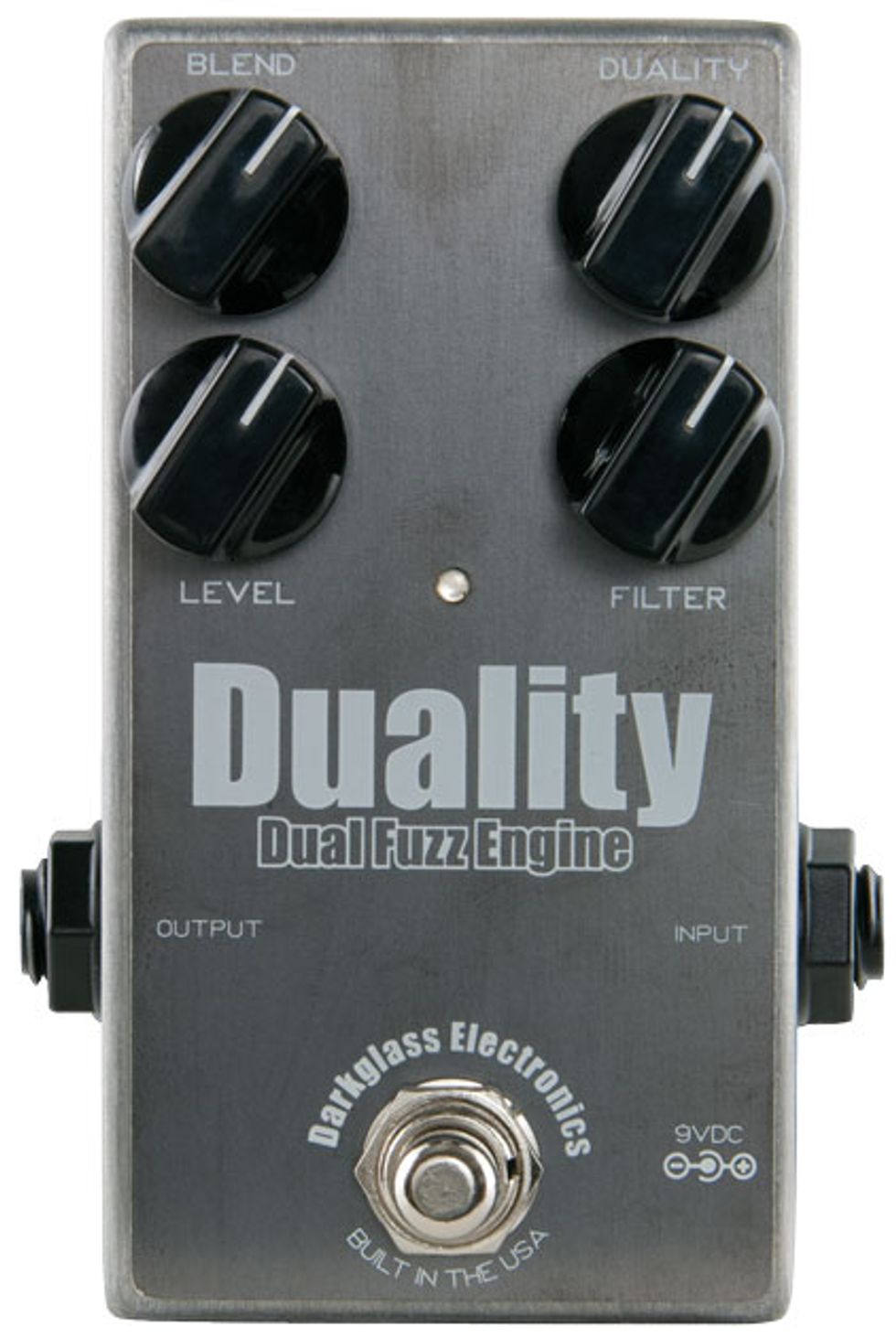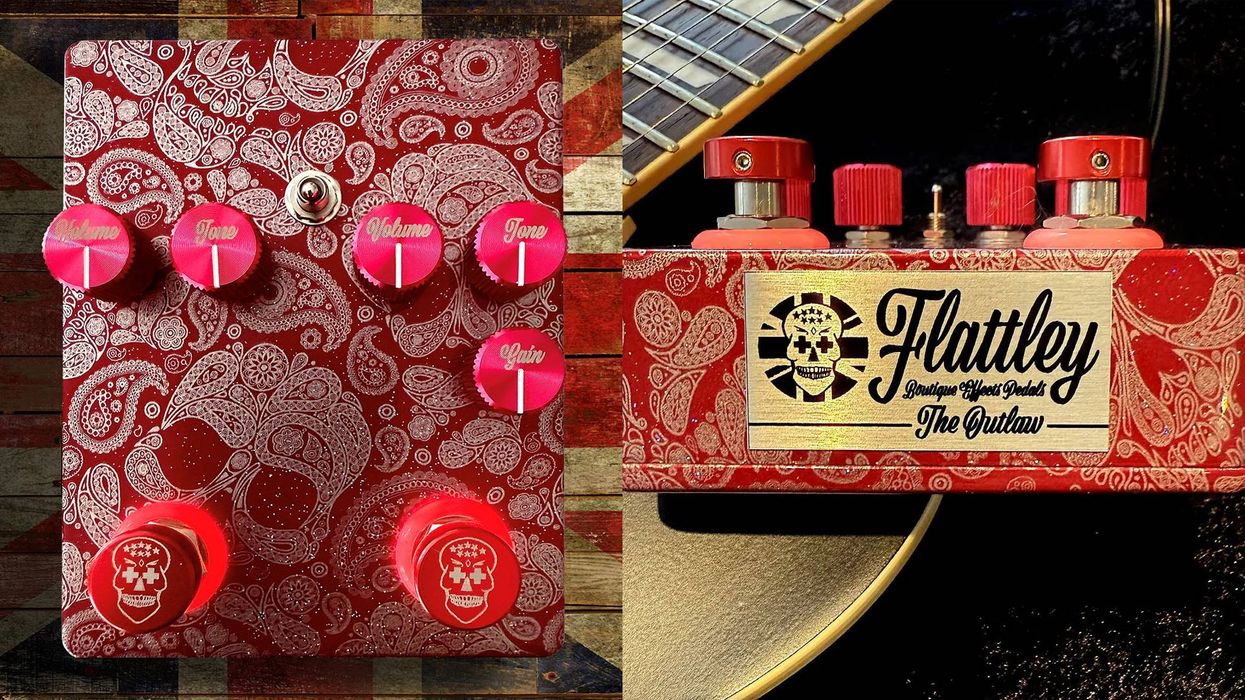Darkglass Electronics doesn’t necessarily trumpet its strong allegiances to the bass community, but the young company builds as many bass-centric effects as guitar-oriented stomps. As the name of its new fuzz suggests, the Duality could live in both worlds. But with a low-pass filter and blend control that enable precise low-end sculpting and exceptionally tight and punchy fuzz, the Duality is very clearly built to address the shortcomings bass players encounter when adapting guitar fuzz to their own unique requirements.
Grey Matter
The look of the pedal mirrors the styling of the company’s Microtubes Vintage, but with a darker hue. Some might find the Duality’s dials a little cramped, but the quartet of tone shapers are logically arranged with a smooth feel.
fired notes with unabashed immediacy.
Our tour begins where the magic happens: the duality dial. Cranking the knob all the way to the left produces a gated, sawtooth sound. Fans of ZVEX’s Wooly Mammoth might dig this setting since it sounds as if the pinch knob of the legendary pedal was maxed out. Dial the duality knob all the way to the right, and you have what Darkglass describes as tighter high-gain fuzz. Where it really gets interesting lies between the two extremes. With a turn of the dial, a player can mix the two fuzz circuits to their taste and produce a wide variety of hybrid fuzz tones.
The accompanying knobs take tone sculpting even further. The blend dial balances the amount of input signal with the effect. Those who feel that some fuzz pedals sap the lows of their initial tone will find this handy as it can preserve the fundamentals while spicing up their sound. Below the blend is the level dial, which acts like a volume knob for the fuzz. Other pedals with similar functions convey a separated sound, where the effect floats above the clean tone. With the Duality’s expertly engineered blend and level controls, you can achieve the optimum fusion between effect and the original signal.
Ratings
Pros:
Big and versatile fuzz tones in a small box.
Cons:
Peculiar placement for the adaptor jack. Price might deter fuzz lovers on a tight budget.
Tones:
Ease of Use:
Build/Design:
Value:
Street:
$249
Darkglass Duality
Dual Fuzz Engine
darkglass.com
Additional tone shaping is provided through the filter knob, which attenuates the highs of the overall sound. It can create timbres ranging from dark roars to grinding metal. Aside from the solid design and smooth components, Darkglass gets kudos for environmental friendliness. You can keep those batteries in your kid’s toys because the only way to power the Duality is with a 9V adaptor. My only quip is the decision to place the adaptor plug below the input jack, which could be cumbersome for some pedalboard configurations.
Dual Delights
The user-friendly Duality pedal was a blast to explore. Initially, I used a Nash P-Style bass and an Epifani AL 112 combo to explore the pedal’s fuzz factors. Instead of using a tube amp that would add some overdrive, dirtying up a clean configuration would better display what the Duality has to offer.
Within seconds of engaging the pedal, this tiny rig turned into a doom machine. Cranking the duality dial all the way to the right (high-gain mode) and setting the filter at 11 o’clock brought out waves of groovy fuzz with full-sounding lows. There was a unique responsiveness as the pedal fired notes with unabashed immediacy. This newfound articulation allowed my right hand to slide in and out of notes with wide-ranging glissandos. It also made string bends sound like a robotic whale.
The sizzles and fizzles using the left side of the dial were perfect for concocting synth bass lines while on a funk gig. Pairing the Duality with a Boss OC-2, I used a 1964 Fender J bass to play lines that would please Parliament fans and cop tones that would satisfy devotees of Stevie Wonder’s synth lines.
At the end of the night, some after-show experimenting took place by turning the duality dial back and forth and mixing the two fuzz circuits to varying degrees. Some of the sounds I created were given a range of descriptors by bandmates from a “vomiting bumblebee” to “Ernie Isley’s Lightsaber.” Colorful descriptions aside, there’s a trove of fuzz tones that can be gleaned from the Darkglass pedal.
The Verdict
The Darkglass Duality Dual Fuzz Engine is clever and well crafted. The ability to craft brilliant and brazen effects is comfortably within the four-knob setup—along with the means for creating a monstrous bass tone. Its price tag might be a touch hefty for some shoppers, but those willing to invest in this steely machine should be quite satisfied with the Duality’s fun and furious features.
























